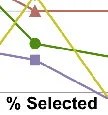Grant Stats
ROSES Selections Data
SMD is pleased to announce the inaugural release of the Research and Analysis Program Yearbook. The Yearbook is SMD’s attempt to provide a single, regularly updated, set of statistics about its research and analysis programs to all interested Individuals. The Yearbook is intended to serve as a “living” resource: as new analyses are performed by the SMD Data Analytics Team, the results will be added to the Yearbook. The Yearbook may be found at https://science.nasa.gov/roses2021yearbook/.
This first release concentrates on comparing information about science teams of proposals submitted to Research Opportunities in Space and Earth Sciences (ROSES) 2021 to the cumulative information about science teams of proposals submitted to ROSES 2016, 2017, 2018, 2019, and 2020. Information about both submitted and selected proposals are discussed. Included in the data are basic demographics of PIs and Co-Is as well as information about the organizations submitting. Also included are data about the proposal selection rates and the duration of the review process for each of SMD’s five Divisions as well as programs that are cross-Divisional (e.g., Exoplanets Research Program).
To make the Yearbook as useful as possible to as many groups as possible, NASA invites comments about data and analyses. Submit your questions or suggestions to hq-smd-yearbook@mail.nasa.gov.
You can find abstracts of the awards from each ROSES program posted on NSPIRES by following this procedure: go to http://nspires.nasaprs.com/external, choose solicitations, then choose “Past Solicitations and Selection Dates” and then either choose the check the box for the year or search on the name or both. For example, for all abstracts from 2020, one would select (down the left side) the 2020 check box. This yields 103 records. One can then use the ‘filter by” box at the upper right of the table to find, say, just one 2020 program element, e.g., type APRA for D.3 Astrophysics Research and Analysis. One can then follow the link from that solicitation title to its NSPIRES page and there is a link to the PDF of the selection document in the lower right of that NSPIRES page. If one wanted many years worth of APRA, then back at the Past Solicitations search in the left column you would leave the Fiscal Year “All” box checked, put APRA in the filter by box to get many years worth of APRAs, each of which links to the corresponding NSPIRES page with the selection document. If the solicitation you are seeking is ‘closed’, not ‘past’ then the abstracts have not yet been posted.
"If you are not after the winners from a particular ROSES program but want to search more broadly, you can use the NSSC grant status page at https://www.nssc.nasa.gov/grantstatus and search by the Institution, PI name or words in the title of the award. That will give you lists of awards but not their abstracts. The NSSC database includes only federal assistance awards to non-governmental organizations, it doesn’t include awards to government labs.
An archive of the submission and selection numbers for the NASA Earth and Space Science Fellowship (NESSF), discontinued after 2018, may be found at /researchers/sara/grant-stats/nasa-earth-and-space-science-fellowship-nessf-selections/. Our current graduate student research program, Future Investigators in NASA Earth and Space Science and Technology, is part of ROSES and data for that program is part of the grant stats spreadsheet above.
Please direct questions or corrections on this page to SARA@nasa.gov






